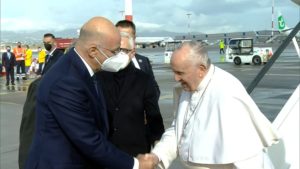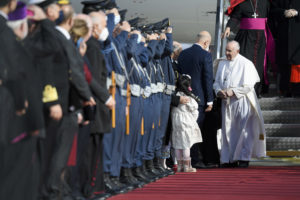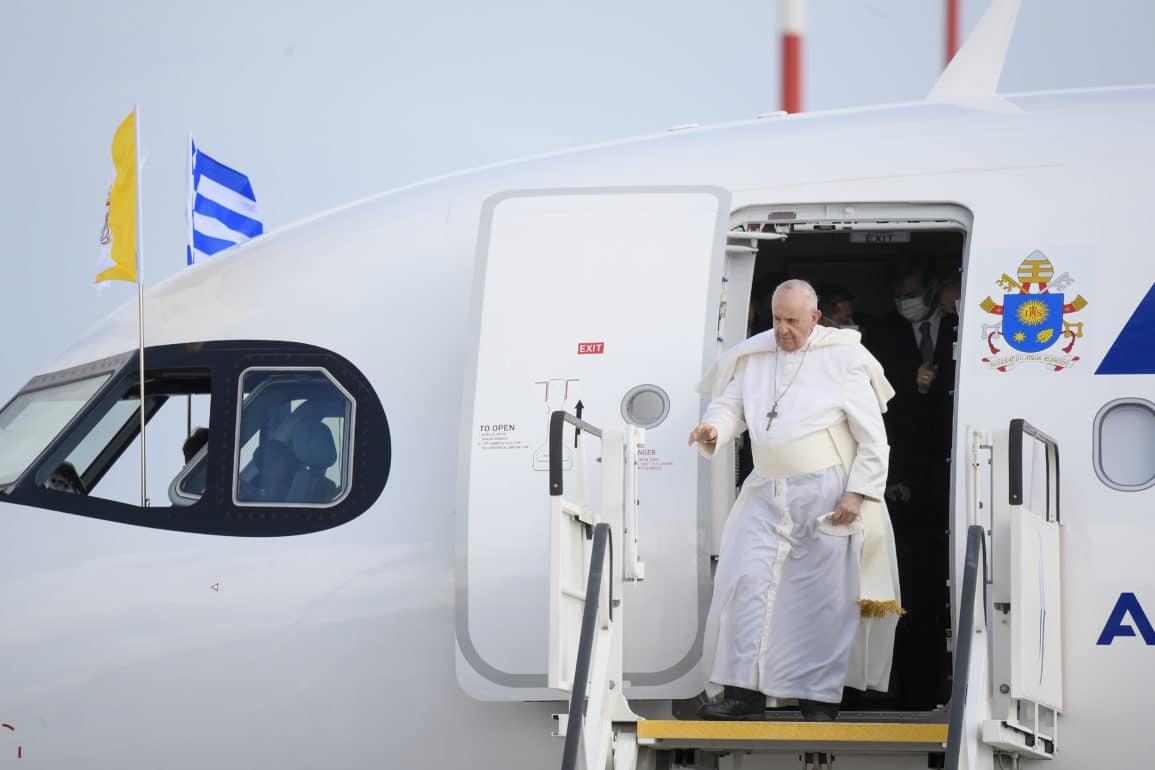Pope Francis is already in Athens, Greece, the second destination of his 35th international apostolic trip to Cyprus and Greece, in the latter nation, his motto is “Let us open ourselves to the surprises of God, who wants his light to shine on our path”.

In this way, while Greece feels the effects of the pandemic and the recent financial crisis, the motto expresses the hope that the visit of the Holy Father will bring a ray of light for the future of Greece, a country with a deep-rooted faith and an illustrious past.
Pope John Paul II visited Greece in 2001, after the Great Jubilee of 2000. On the other hand, this visit to Greece will be Francis’ second, since, on April 16, 2016, he went one day to the Greek island of Lesbos. On this trip, His Holiness visited the Moria refugee camp together with the Patriarch of Constantinople, Bartholomew I, and the Archbishop of Athens and all of Greece, Jerome II.
Likewise, on the flight back to the Vatican, he was accompanied by three Syrian refugee families, offering asylum to the 12, including six children. The Moria refugee camp was closed in September 2020 due to a fire that destroyed much of it.
Welcome at the airport

At around 11:10 (10:10 in Rome), the papal flight landed at Athens airport, after traveling 895 km from Larnaca, Cyprus, where it was departed this morning. The Apostolic Nuncio to Greece, Bishop Savio Hon Tai-Fai, the Chief of Protocol and the Minister of Foreign Affairs of Greece, came to receive and greet the Pope at the foot of the front stairs of the plane
Four children in traditional costumes offer her flowers as a welcome sign. After the presentation of the delegations and the Guard of Honor, Francisco drives to the Presidential Palace for the official welcome ceremony.
Greece, eminently Orthodox
Evangelized from the 1st century onwards, mainly through the preaching of Saint Paul (cf. Acts of the Apostles), and submitted to the jurisdiction of the Patriarchate of Constantinople in the year 732, Greece became Orthodox after the Great Eastern Schism in the 11th century. Autocephalous (not dependent on the jurisdiction of a patriarch) since 1850, the Greek Orthodox Church is the official church of the State and Orthodoxy is the religion professed by the vast majority of Greeks. Among the other religious minorities in the country, in addition to Catholics, there are Protestant and Muslim communities (some 150,000, concentrated mainly in Thrace, on the border with Turkey) and a small Jewish community.
Catholic presence
Catholics in the country number 133,000 out of a population of almost 11 million (1.2%). Less than half of them are Greek. In recent decades, the presence of Catholics of foreign origin who have settled permanently in Greece has grown significantly.
To these must be added several thousand migrant workers with temporary residence permits and asylum seekers. The largest groups are the Poles (40,000) and the Filipinos (45,000). The number of Catholics from Middle Eastern countries has also increased because of the war, particularly from Iraq (4,000) and Syria. There are also Albanians, Bulgarians, Ukrainians, and Armenians. In 2018, the Greek Church estimated the actual number of Catholics in the country at about 400,000.
Athens
Today, the capital of Greece is the political, economic, and cultural center of the nation and a major international tourist destination. Athens has two UNESCO World Heritage Sites: the Acropolis, in the center of the city, and the Dafni (or Dafni) monastery, founded at the end of the 6th century in the current north-western district of Chaidari.
On the Acropolis are the remains of the Parthenon (the ancient temple of Athena), the temple of Athena Nike, the Erechtheion with its spectacular Porch of the Caryatids, the Theater of Dionysus Eleutherius, and the Odeon of Pericles.
Other historical places are the ancient Agora, to the northwest of the Acropolis, which was the center of the civic life of the city; the ruins of the Temple of Olympian Zeus; Hadrian’s Gate; and the Panathinaiko Stadium, which hosted the first modern Olympic Games in 1896.
The most prominent areas of the capital are Syntagma Square, the great square of Athens, where the Parliament is located; the Plaka neighborhood, full of shops, restaurants, and bars; the Monastiraki neighborhood, where there are bazaars with all kinds of merchandise; Psiri, an old popular neighborhood along Miaoùli and Evripìdou streets, with local craft shops, antique dealers, clubs and restaurants; and Gazi, a very lively area, frequented by young people and artists.
Behind the Greek Parliament is the National Garden with a pond, a small zoo, a botanical museum, and a children’s playground. The main museums in the capital are the National Archaeological Museum; the Byzantine and Christian Museum; the Benaki Museum, with works ranging from the Hellenistic period to the present; the Museum of Cycladic and Ancient Greek Art; the Museum of Greek Folk Art; the Frissiras Museum, dedicated to modern Greek and European painting; and the María Callas Museum, which houses objects and photographs related to the famous soprano.
The Metropolitan Cathedral of the Annunciation (1842) is the main church of the capital and the seat of the Archbishop of Athens and all of Greece. Next to it is the small Romanesque-Byzantine church of Agios Eleftherios (12C).
In Ermou, the most famous shopping street in Athens is the Kapnikarea Byzantine church, built in 1050. In a small cave, behind the Theater of Dionysus, on the Acropolis, you can admire the small church of Panagia Hrysospiliotissa and, in the Agora, the first major church built in the capital, in the 10th century, the Church of the Holy Apostles of Solaki. The catholic cathedral of San Dionisio Areopagita (1844) is located in Syntagma.










